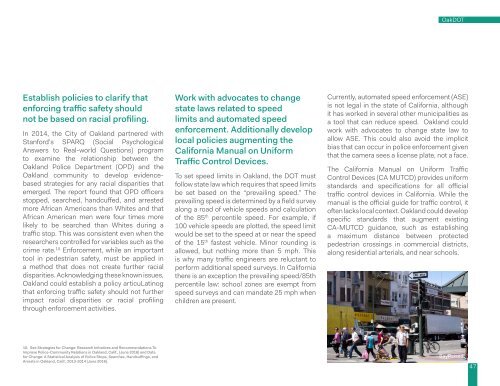Oakland Walks!
oak063431
oak063431
Create successful ePaper yourself
Turn your PDF publications into a flip-book with our unique Google optimized e-Paper software.
OakDOT<br />
Establish policies to clarify that<br />
enforcing traffic safety should<br />
not be based on racial profiling.<br />
In 2014, the City of <strong>Oakland</strong> partnered with<br />
Stanford’s SPARQ (Social Psychological<br />
Answers to Real-world Questions) program<br />
to examine the relationship between the<br />
<strong>Oakland</strong> Police Department (OPD) and the<br />
<strong>Oakland</strong> community to develop evidencebased<br />
strategies for any racial disparities that<br />
emerged. The report found that OPD officers<br />
stopped, searched, handcuffed, and arrested<br />
more African Americans than Whites and that<br />
African American men were four times more<br />
likely to be searched than Whites during a<br />
traffic stop. This was consistent even when the<br />
researchers controlled for variables such as the<br />
crime rate. 10 Enforcement, while an important<br />
tool in pedestrian safety, must be applied in<br />
a method that does not create further racial<br />
disparities. Acknowledging these known issues,<br />
<strong>Oakland</strong> could establish a policy articuLatinog<br />
that enforcing traffic safety should not further<br />
impact racial disparities or racial profiling<br />
through enforcement activities.<br />
Work with advocates to change<br />
state laws related to speed<br />
limits and automated speed<br />
enforcement. Additionally develop<br />
local policies augmenting the<br />
California Manual on Uniform<br />
Traffic Control Devices.<br />
To set speed limits in <strong>Oakland</strong>, the DOT must<br />
follow state law which requires that speed limits<br />
be set based on the “prevailing speed.” The<br />
prevailing speed is determined by a field survey<br />
along a road of vehicle speeds and calculation<br />
of the 85 th percentile speed. For example, if<br />
100 vehicle speeds are plotted, the speed limit<br />
would be set to the speed at or near the speed<br />
of the 15 th fastest vehicle. Minor rounding is<br />
allowed, but nothing more than 5 mph. This<br />
is why many traffic engineers are reluctant to<br />
perform additional speed surveys. In California<br />
there is an exception the prevailing speed/85th<br />
percentile law: school zones are exempt from<br />
speed surveys and can mandate 25 mph when<br />
children are present.<br />
Currently, automated speed enforcement (ASE)<br />
is not legal in the state of California, although<br />
it has worked in several other municipalities as<br />
a tool that can reduce speed. <strong>Oakland</strong> could<br />
work with advocates to change state law to<br />
allow ASE. This could also avoid the implicit<br />
bias that can occur in police enforcement given<br />
that the camera sees a license plate, not a face.<br />
The California Manual on Uniform Traffic<br />
Control Devices (CA MUTCD) provides uniform<br />
standards and specifications for all official<br />
traffic control devices in California. While the<br />
manual is the official guide for traffic control, it<br />
often lacks local context. <strong>Oakland</strong> could develop<br />
specific standards that augment existing<br />
CA-MUTCD guidance, such as establishing<br />
a maximum distance between protected<br />
pedestrian crossings in commercial districts,<br />
along residential arterials, and near schools.<br />
10. See Strategies for Change: Research Initiatives and Recommendations To<br />
Improve Police-Community Relations in <strong>Oakland</strong>, Calif., (June 2016) and Data<br />
for Change: A Statistical Analysis of Police Stops, Searches, Handcuffings, and<br />
Arrests in <strong>Oakland</strong>, Calif., 2013-2014 (June 2016).<br />
BayRaised<br />
47


